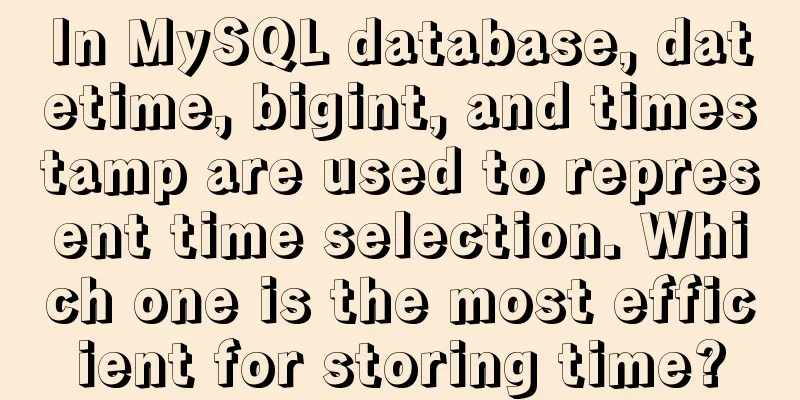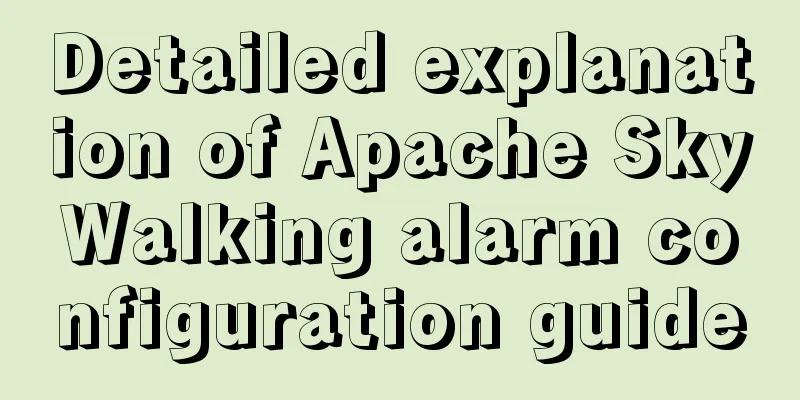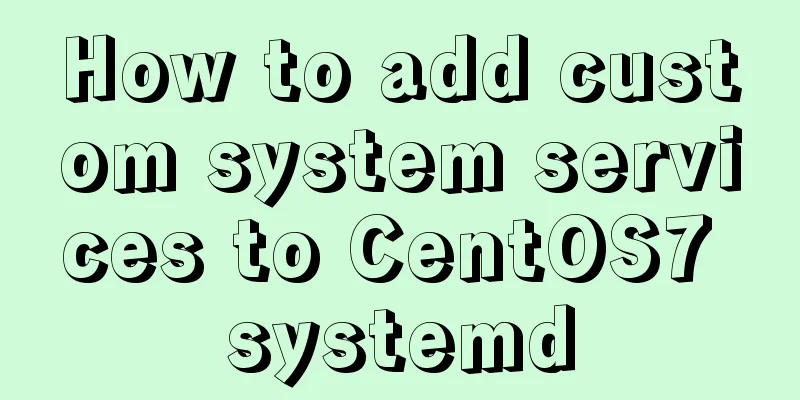In MySQL database, datetime, bigint, and timestamp are used to represent time selection. Which one is the most efficient for storing time?

|
In the database, datetime, bigint, and timestamp can be used to represent time. So which type is more appropriate to choose to store time? # Post-data preparationInsert 50w data into the database through the program Data Sheet: CREATE TABLE `users` ( `id` int(11) NOT NULL AUTO_INCREMENT, `time_date` datetime NOT NULL, `time_timestamp` timestamp NOT NULL DEFAULT CURRENT_TIMESTAMP ON UPDATE CURRENT_TIMESTAMP, `time_long` bigint(20) NOT NULL, PRIMARY KEY (`id`), KEY `time_long` (`time_long`), KEY `time_timestamp` (`time_timestamp`), KEY `time_date` (`time_date`) ) ENGINE=InnoDB AUTO_INCREMENT=500003 DEFAULT CHARSET=latin1 Among them, time_long, time_timestamp, and time_date are different storage formats for the same time. Entity class users
/**
* @author hetiantian
* @date 2018/10/21
* */
@Builder
@Data
public class Users {
/**
* Self-incrementing unique id
* */
private Long id;
/**
* Date type time * */
private Date timeDate;
/**
*Time of timestamp type* */
private Timestamp timeTimestamp;
/**
* Long type time * */
private long timeLong;
}
DAO layer interface
/**
* @author hetiantian
* @date 2018/10/21
* */
@Mapper
public interface UsersMapper {
@Insert("insert into users(time_date, time_timestamp, time_long) value(#{timeDate}, #{timeTimestamp}, #{timeLong})")
@Options(useGeneratedKeys = true,keyProperty = "id",keyColumn = "id")
int saveUsers(Users users);
}
The test class inserts data into the database
public class UsersMapperTest extends BaseTest {
@Resource
private UsersMapper usersMapper;
@Test
public void test() {
for (int i = 0; i < 500000; i++) {
long time = System.currentTimeMillis();
usersMapper.saveUsers(Users.builder().timeDate(new Date(time)).timeLong(time).timeTimestamp(new Timestamp(time)).build());
}
}
}
To generate data code, go to github: https://github.com/TiantianUpup/sql-test/ If you don’t want to use code generation, but want to import data through a sql file, the sql file network disk address is attached at the end of the article. # SQL query rate testQuery by datetime type: select count(*) from users where time_date >="2018-10-21 23:32:44" and time_date <="2018-10-21 23:41:22" Time taken: 0.171 Query by timestamp type select count(*) from users where time_timestamp >= "2018-10-21 23:32:44" and time_timestamp <="2018-10-21 23:41:22" Time taken: 0.351 Query by bigint type select count(*) from users where time_long >=1540135964091 and time_long <=1540136482372 Time taken: 0.130s Conclusion Under the InnoDB storage engine, the performance of searching by time range is bigint > datetime > timestamp # SQL group rate test
Group by datetime type: select time_date, count(*) from users group by time_date Time taken: 0.176s Group by timestamp type: select time_timestamp, count(*) from users group by time_timestamp Time taken: 0.173s Conclusion: Under the InnoDB storage engine, by time grouping, the performance of timestamp > datetime, but the difference is not big. # sql sorting rate testSort by datetime type: select * from users order by time_date Time taken: 1.038s Sort by timestamp type select * from users order by time_timestamp Time taken: 0.933s Sort by bigint type select * from users order by time_long Time taken: 0.775s Conclusion: Under the InnoDB storage engine, by time sorting, the performance of bigint > timestamp > datetime # SummaryIf you need to operate on the time field (such as searching or sorting by time range, etc.), it is recommended to use bigint. If the time field does not need any operation, it is recommended to use timestamp. Using 4 bytes to save space is more convenient, but the recorded time is limited to 2038. The SQL file network disk address in the article: Link: https://pan.baidu.com/s/1cCRCxtTlPriXMERGsbnb_A Extraction code: hbq2 This concludes this article about choosing between datetime, bigint, and timestamp to represent time in MySQL database, and which one is the most efficient for storing time. For more information about database datetime, bigint, and timestamp, please search previous articles on 123WORDPRESS.COM or continue browsing the following related articles. I hope you will support 123WORDPRESS.COM in the future! You may also be interested in:
|
<<: 10 Things Excellent Web Developers Must Know to Improve Their Development Skills
>>: A brief analysis of CSS :is() and :where() coming to browsers soon
Recommend
Specific use of useRef in React
I believe that people who have experience with Re...
Detailed code of the example of downloading the docker installation package from yum and installing it on an offline machine
1. On a networked machine, use the default centos...
Detailed explanation of the use of title tags and paragraph tags in XHTML
XHTML Headings Overview When we write Word docume...
MySQL 5.7.16 ZIP package installation and configuration tutorial
This article shares the installation and configur...
Solve the problem of changing the password when logging in for the first time after installing MySQL 8.0
Here is an introduction to changing the password ...
A detailed guide to custom directives in Vue
Table of contents 1. What is a custom instruction...
Centos8.3, docker deployment springboot project actual case analysis
introduction Currently, k8s is very popular, and ...
Teach you the detailed process of using Docker to build the Chinese version of gitlab community
1. Use Docker Compose to configure startup If you...
Detailed explanation of several ways to create objects and object methods in js
This article is the second article about objects ...
Detailed explanation of MySQL locks (table locks, row locks, shared locks, exclusive locks, gap locks)
In real life, a lock is a tool we use when we wan...
Detailed explanation of the solution to forget the password in MySQL 5.7
ENV: [root@centos7 ~]# uname -r 3.10.0-514.el7.x8...
Native JS realizes the special effect of spreading love by mouse sliding
This article shares with you a js special effect ...
MySQL configuration SSL master-slave replication
MySQL5.6 How to create SSL files Official documen...
Complete step-by-step record of MySQL 8.0.26 installation and uninstallation
Table of contents Preface 1. Installation 1. Down...
Getting Started Tutorial on Animating SVG Path Strokes Using CSS3
Without relying on JavaScript, pure CSS is used t...









